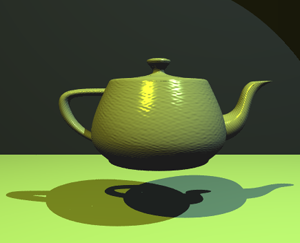3D rendering





3D rendering
3D rendering is the process of converting 3D models into 2D images on a computer. This process is essential in various fields such as architecture, video games, film production, simulation, and virtual reality. The resulting images can be either static or animated, depending on the requirements of the project.
Process[edit]
The 3D rendering process involves several steps:
1. **Modeling**: Creating the 3D objects using 3D modeling software. This step involves defining the shape, size, and structure of the objects. 2. **Texturing**: Applying textures to the 3D models to give them color and detail. This can include bump mapping, normal mapping, and displacement mapping. 3. **Lighting**: Setting up light sources to illuminate the scene. This can include ambient lighting, point lighting, directional lighting, and spot lighting. 4. **Rendering**: The actual process of generating the 2D image from the 3D scene. This can be done using various rendering techniques such as ray tracing, rasterization, and path tracing. 5. **Post-processing**: Enhancing the rendered image with effects like bloom, depth of field, and motion blur.
Techniques[edit]
There are several techniques used in 3D rendering:
- **Ray Tracing**: A technique that simulates the way light interacts with objects to produce highly realistic images. It traces the path of light rays as they travel through the scene.
- **Rasterization**: A technique that converts 3D models into a 2D image by projecting them onto a screen. It is commonly used in real-time applications like video games.
- **Path Tracing**: An advanced form of ray tracing that simulates the global illumination of a scene by tracing the paths of many light rays.
Applications[edit]
3D rendering is used in various applications:
- **Architecture**: Creating realistic visualizations of buildings and structures before they are built.
- **Video Games**: Rendering real-time graphics for interactive gameplay.
- **Film Production**: Generating special effects and animated sequences.
- **Simulation**: Creating realistic environments for training and research.
- **Virtual Reality**: Rendering immersive 3D environments for VR experiences.
Software[edit]
Several software packages are commonly used for 3D rendering:
See Also[edit]
- 3D computer graphics
- Computer-generated imagery
- Rendering (computer graphics)
- Shading
- Texture mapping
- Global illumination
References[edit]
<references group="" responsive="1"></references>
External Links[edit]

This article is a computer graphics–related stub. You can help WikiMD by expanding it!
Ad. Transform your life with W8MD's Budget GLP-1 injections from $75


W8MD offers a medical weight loss program to lose weight in Philadelphia. Our physician-supervised medical weight loss provides:
- Weight loss injections in NYC (generic and brand names):
- Zepbound / Mounjaro, Wegovy / Ozempic, Saxenda
- Most insurances accepted or discounted self-pay rates. We will obtain insurance prior authorizations if needed.
- Generic GLP1 weight loss injections from $75 for the starting dose.
- Also offer prescription weight loss medications including Phentermine, Qsymia, Diethylpropion, Contrave etc.
NYC weight loss doctor appointmentsNYC weight loss doctor appointments
Start your NYC weight loss journey today at our NYC medical weight loss and Philadelphia medical weight loss clinics.
- Call 718-946-5500 to lose weight in NYC or for medical weight loss in Philadelphia 215-676-2334.
- Tags:NYC medical weight loss, Philadelphia lose weight Zepbound NYC, Budget GLP1 weight loss injections, Wegovy Philadelphia, Wegovy NYC, Philadelphia medical weight loss, Brookly weight loss and Wegovy NYC
|
WikiMD's Wellness Encyclopedia |
| Let Food Be Thy Medicine Medicine Thy Food - Hippocrates |
Medical Disclaimer: WikiMD is not a substitute for professional medical advice. The information on WikiMD is provided as an information resource only, may be incorrect, outdated or misleading, and is not to be used or relied on for any diagnostic or treatment purposes. Please consult your health care provider before making any healthcare decisions or for guidance about a specific medical condition. WikiMD expressly disclaims responsibility, and shall have no liability, for any damages, loss, injury, or liability whatsoever suffered as a result of your reliance on the information contained in this site. By visiting this site you agree to the foregoing terms and conditions, which may from time to time be changed or supplemented by WikiMD. If you do not agree to the foregoing terms and conditions, you should not enter or use this site. See full disclaimer.
Credits:Most images are courtesy of Wikimedia commons, and templates, categories Wikipedia, licensed under CC BY SA or similar.
Translate this page: - East Asian
中文,
日本,
한국어,
South Asian
हिन्दी,
தமிழ்,
తెలుగు,
Urdu,
ಕನ್ನಡ,
Southeast Asian
Indonesian,
Vietnamese,
Thai,
မြန်မာဘာသာ,
বাংলা
European
español,
Deutsch,
français,
Greek,
português do Brasil,
polski,
română,
русский,
Nederlands,
norsk,
svenska,
suomi,
Italian
Middle Eastern & African
عربى,
Turkish,
Persian,
Hebrew,
Afrikaans,
isiZulu,
Kiswahili,
Other
Bulgarian,
Hungarian,
Czech,
Swedish,
മലയാളം,
मराठी,
ਪੰਜਾਬੀ,
ગુજરાતી,
Portuguese,
Ukrainian